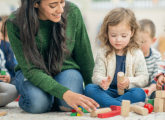Carole Skinner has lots of EYFS construction ideas that will give children a solid foundation in numeracy…
Young children love designing, making and building things, and they learn a lot of maths through working with construction materials.
Inspiring their constructional play and mathematical creativity can be as simple as providing a well-resourced construction area and some thought-provoking building ideas and activities.
And it’s not only maths skills children are developing when they’re working together and sharing the process of building a house or a bridge, or being pleased with a model they’ve made; it all does wonders for their personal and social development too.
Your construction area should offer children a place for them to explore, investigate and use a range of building materials.
There are small changes you can make in your construction provision and organisation that will have a big impact on children’s access to maths ideas.
Try setting up a ‘tinker table’ with small, fiddly pieces of equipment such as nuts and bolts, washers and other small things that can be taken apart.
Supply materials that enable children to practise different manipulative skills and use words such as twist, screw, push, pull and turn.
Include shapes that fit together and everyday items such as plastic cups that stack up inside each other and sweet tubes that don’t.
Make sure there are construction resources located both indoors and outdoors. Indoors, provide construction sets that develop small motor skills, with table modelling and glue and paint, cardboard boxes and cylinders.
Introducing small-world people, farm and jungle animals or cars will encourage story-making and give children the opportunity to use maths language.
You could ask children to explain how many different types of cars there are in the garage they made and how many there are altogether.
Outdoors, where everything is on a much larger scale, use big construction materials. These invite children to build as a team and engage them in talk and cooperative play.
Of course, children will need time to investigate the boxes, climbing inside and sitting on top before they begin a major construction.
Add camouflage netting and silver foil survival blankets to help give a realistic effect to built caves and dens.
Resource a box with natural materials and encourage children to make constructions for a real purpose: sticks to make a framework for the beans to grow up, twigs and clothes to make scarecrows, and stepping stones and pebbles to construct pathways, as well as the usual houses, castles and tower builds that are part of children’s play.
Working with construction materials allows children to develop their maths understanding by talking, using number language, exploring shape and space, estimating and measuring, making predictions and recording results.
The maths learning is focused on counting, calculating, shape and the language of measurement – how big, how wide, how long a model will need to be, or how tall a construction actually is, with children getting a feel for the appropriate sizes and a purposeful context for measuring.
Sorting for a purpose occurs quite naturally as children choose the recycled materials that they want to build with or collect together all the red plastic bricks they need to make a house.
You can encourage sorting by suggesting they categorise some of the building materials into separate boxes and let them decide on the appropriate categories, such as the ‘wooden cylinders’ or ‘not very good for building shapes’.
You can support children by using positional language, for instance, words such as ‘behind’, ‘in front of’ and ‘next to’ when you’re talking about their constructions.
Offer children shape and space words so that children can describe their buildings and say what they used to build them.
Finally there’s always a focus on solving problems in construction play. Children visualise the shape they’ll make if they glue some boxes together.
They decide how many wheels they need or work out how much material they want. Children talk about what they’re doing, develop and test ideas and record in different ways.
Inspire children with these exciting building projects. Each one will encourage a problem-solving approach…
1. How tall can you build a tower before it falls down?
2. Can you completely cover the table top with bricks?
3. Is it possible to build a wall with a window to look through?
4. Put a box inside a box inside a box inside a box…
5. What can you build using 10 bricks?
6. What can you build using different-sized cuboids?
7. Make a bed for a teddy.
8. Use the crates to make a den for superheroes.
9. Build a bridge strong enough for the toy tractor to drive across.
10. Make a house for a mouse.
The equipment needs to be organised in boxes or crates (preferably wheeled), labelled with both picture and prints.
Add maths to the labels by writing ‘10 wheels’ and ‘20 very large blocks’ as well as naming the shapes that are in the box.
Carole Skinner is an independent early years consultant and founder associate of Early Education. She is the co-author of Foundations of Mathematics: An Active Approach to Number, Shape and Measures in the Early Years.

All About Me – Making maths personal in Early Years
Editors picks
